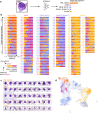Explainable AI identifies diagnostic cells of genetic AML subtypes
- PMID: 36921004
- PMCID: PMC10016704
- DOI: 10.1371/journal.pdig.0000187
Explainable AI identifies diagnostic cells of genetic AML subtypes
Abstract
Explainable AI is deemed essential for clinical applications as it allows rationalizing model predictions, helping to build trust between clinicians and automated decision support tools. We developed an inherently explainable AI model for the classification of acute myeloid leukemia subtypes from blood smears and found that high-attention cells identified by the model coincide with those labeled as diagnostically relevant by human experts. Based on over 80,000 single white blood cell images from digitized blood smears of 129 patients diagnosed with one of four WHO-defined genetic AML subtypes and 60 healthy controls, we trained SCEMILA, a single-cell based explainable multiple instance learning algorithm. SCEMILA could perfectly discriminate between AML patients and healthy controls and detected the APL subtype with an F1 score of 0.86±0.05 (mean±s.d., 5-fold cross-validation). Analyzing a novel multi-attention module, we confirmed that our algorithm focused with high concordance on the same AML-specific cells as human experts do. Applied to classify single cells, it is able to highlight subtype specific cells and deconvolve the composition of a patient's blood smear without the need of single-cell annotation of the training data. Our large AML genetic subtype dataset is publicly available, and an interactive online tool facilitates the exploration of data and predictions. SCEMILA enables a comparison of algorithmic and expert decision criteria and can present a detailed analysis of individual patient data, paving the way to deploy AI in the routine diagnostics for identifying hematopoietic neoplasms.
Copyright: © 2023 Hehr et al. This is an open access article distributed under the terms of the Creative Commons Attribution License, which permits unrestricted use, distribution, and reproduction in any medium, provided the original author and source are credited.
Conflict of interest statement
I have read the journal’s policy and the authors of this manuscript have the following competing interests: TH declares part ownership of Munich Leukemia Laboratory (MLL). CP declares employment at MLL.
Figures



References
LinkOut - more resources
Full Text Sources
Other Literature Sources
